|
Halifax Minster
 Halifax Minster is the minster church of Halifax, Calderdale, West Yorkshire, England. The church is dedicated to St John the Baptist. The parish church of the town, it was granted minster status in 2009. Halifax Minster is one of three churches in the county of West Yorkshire to be given this honorific title; the other two are Dewsbury Minster and Leeds Minster. Halifax Minster, which stands on the site of an earlier Norman church, was built during the 15th century, although the Rokeby and Holdsworth Chapels were not completed until around 1530. The organ was built by John Snetzler in 1763 and installed in 1766. Other notable features of the church include a medieval font cover, Jacobean box pews, and the tombstone of 19th-century diarist Anne Lister. HistoryThe first church on this spot, thought to date from around 1120, was owned and operated by the Cluniac monks of Lewes Priory. Some portions of the stonework of this church have been incorporated into the present building – most notably the carved chevron stones in the north wall of the nave and elsewhere.[2] It has been suggested that one section of the north wall was actually the south wall of the Norman church.[3][4] Several early medieval grave covers also survive.[2] The present church was built in the fifteenth century, apparently fulfilling a need for "more spacious accommodation for the growing population of the parish".[5] The nave and chancel were completed around 1450.[6] At some time between 1455 and 1480, the eastern wall was made higher to accommodate a clerestory.[5][7] Work on the church tower began in the 1440s; it took over three decades to complete, as it was still under construction in 1482.[5] The Rokeby and Holdsworth Chapels, built at the expense of former vicars William Rokeby and Robert Holdsworth, were completed around 1530.[8] William Rokeby's heart and bowels are buried beneath his chapel, as stipulated in his will.[9] Jacobean box pews are a prominent feature of the Minster, and most of those in the nave date from 1633 to 1634. A pew in the centre aisle bears the remains of a memorial brass to John Waterhouse, who died in 1539/40. The carved arms of Richard Sunderland of High Sunderland, who died in 1634, are attached to another pew. Several ancient pew nameplates may be seen attached to a board on the inner north wall of the tower, the oldest dates to 1615 and reads: "This stall made at the cost of Robert Fisher of Halifax."[10] A small portion of medieval stained-glass survives in the upper westernmost clerestory window, which was removed from other windows in the mid-19th century. The Puritans, who were prominent in the town in the 17th century, thought stained glass with its "images" was an abomination. During the Commonwealth (1649–1660) many plain-glass leaded windows of a unique design were installed, paid for by Mrs Dorothy Waterhouse. Many of these were later replaced by Victorian stained glass, but those that survived in 1958 were carefully rebuilt. At that date there were three of these on each side of the chancel, but now there are five on the south side and only one on the north.[11] The large west window in the tower is a late 19th-century reconstruction of a Commonwealth window dating from 1657, but contains no original work. The great east window of the church depicts the crucifixion and resurrection of Jesus, and was completed in 1856. It is the work of George Hedgeland (1825–98), and is based on a design which won first prize for stained glass at the Great Exhibition of 1851.[12] The remaining glass in the church dates also from the Victorian and Edwardian periods. In 1878 and 1879 a great internal restoration of the church took place, initiated by Vicar Francis Pigou (1875–88), and carried out under the direction of George Gilbert Scott and his son John Oldrid Scott. This work involved the removal of galleries, the altering of floor levels, and the removal of plaster from the internal walls.[1][13] A more recent reordering scheme took place in 1983, when pews at the east end of the nave were removed, and a dais installed for the nave altar. At the millennium, after an appeal, Victorian pews were removed from the west end of the church, to provide a more open reception area, with adjacent fitted kitchen. On 31 March 2007, the stand of the 1st Battalion, Duke of Wellington's Regiment (West Riding) Regulation Colours were laid up in the church. The Colour party, with 2 escorts of 40 troops, marched through Halifax from the town hall, preceded by the Regimental Drums and the Heavy Cavalry and Cambrai Band. There was a short ceremony in the Minster grounds where the troops were inspected by Colin Stout, the then-Mayor of Halifax, and Ingrid Roscoe, Lord Lieutenant of West Yorkshire. The church was granted minster status on 23 November 2009.[14][15] Features 
OrganThe church houses an organ built by John Snetzler, installed in 1766. The organ has been enlarged several times in the 19th and 20th centuries, and was completely rebuilt in 1928 by Harrison & Harrison of Durham. Only a small amount of the Snetzler work remains in the present instrument.[25][26][27] List of organists
See alsoReferences
External linksWikimedia Commons has media related to Halifax Minster.
|
|||||||||||||||||||||||||||||||||||||||||||||||||||||||||||||||||||||||||||||||||||||||||||||||||||||||||||||||||||||||||||||||||||
Portal di Ensiklopedia Dunia

